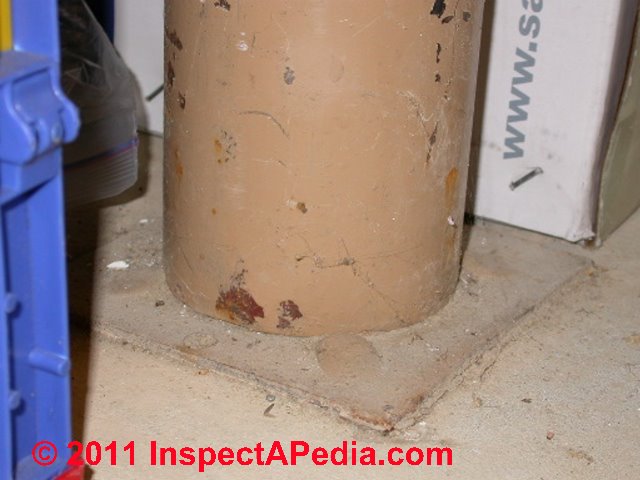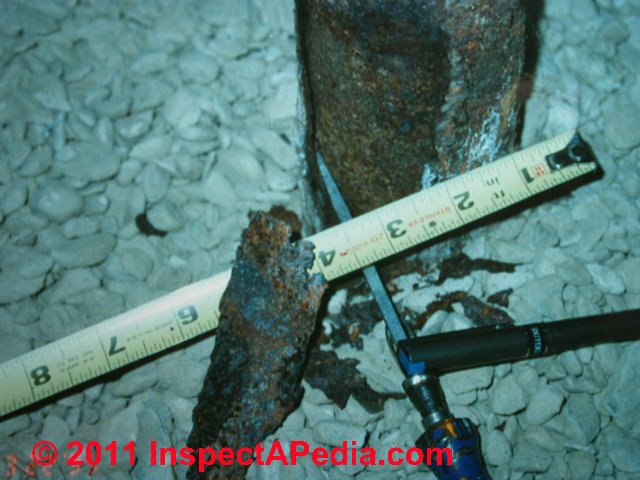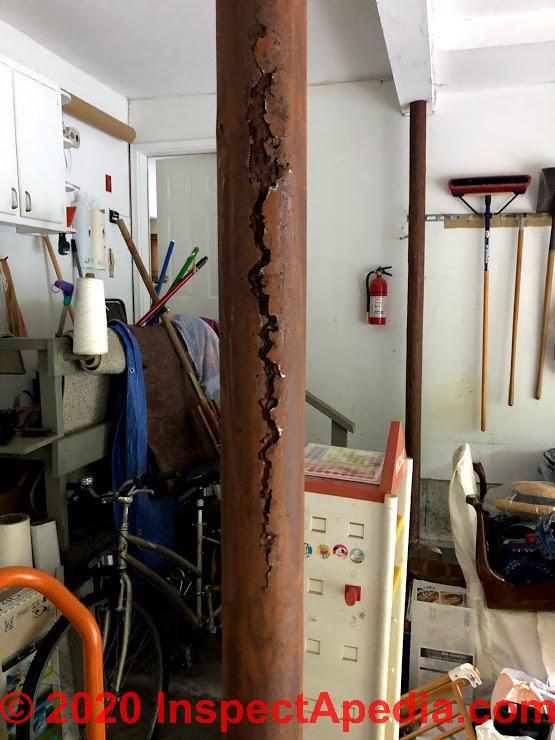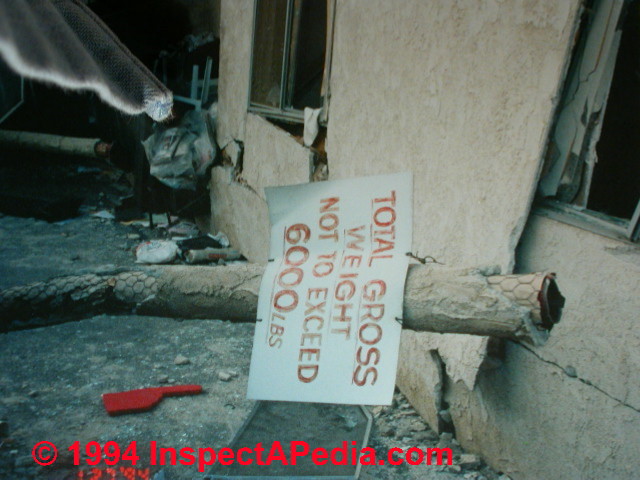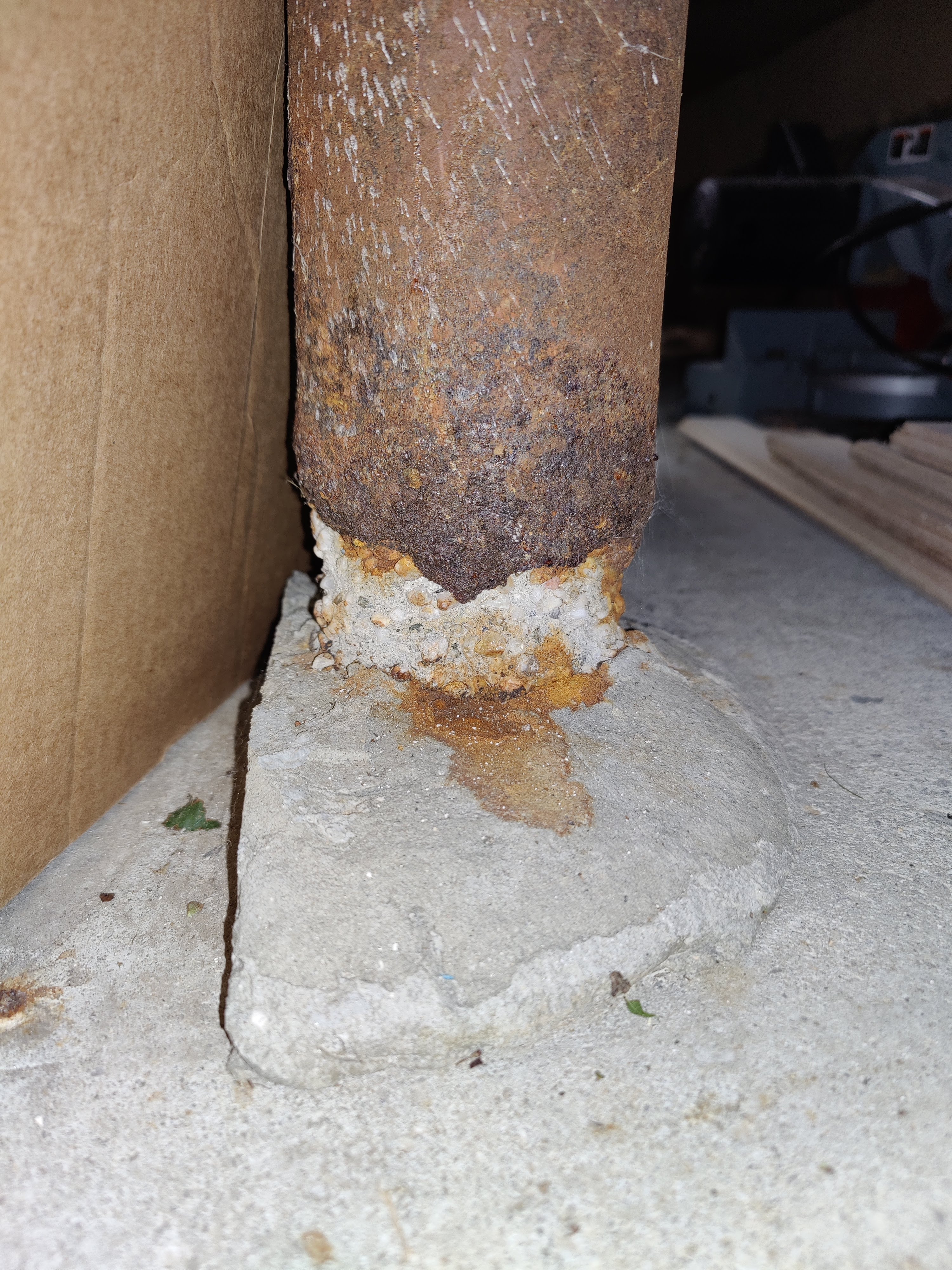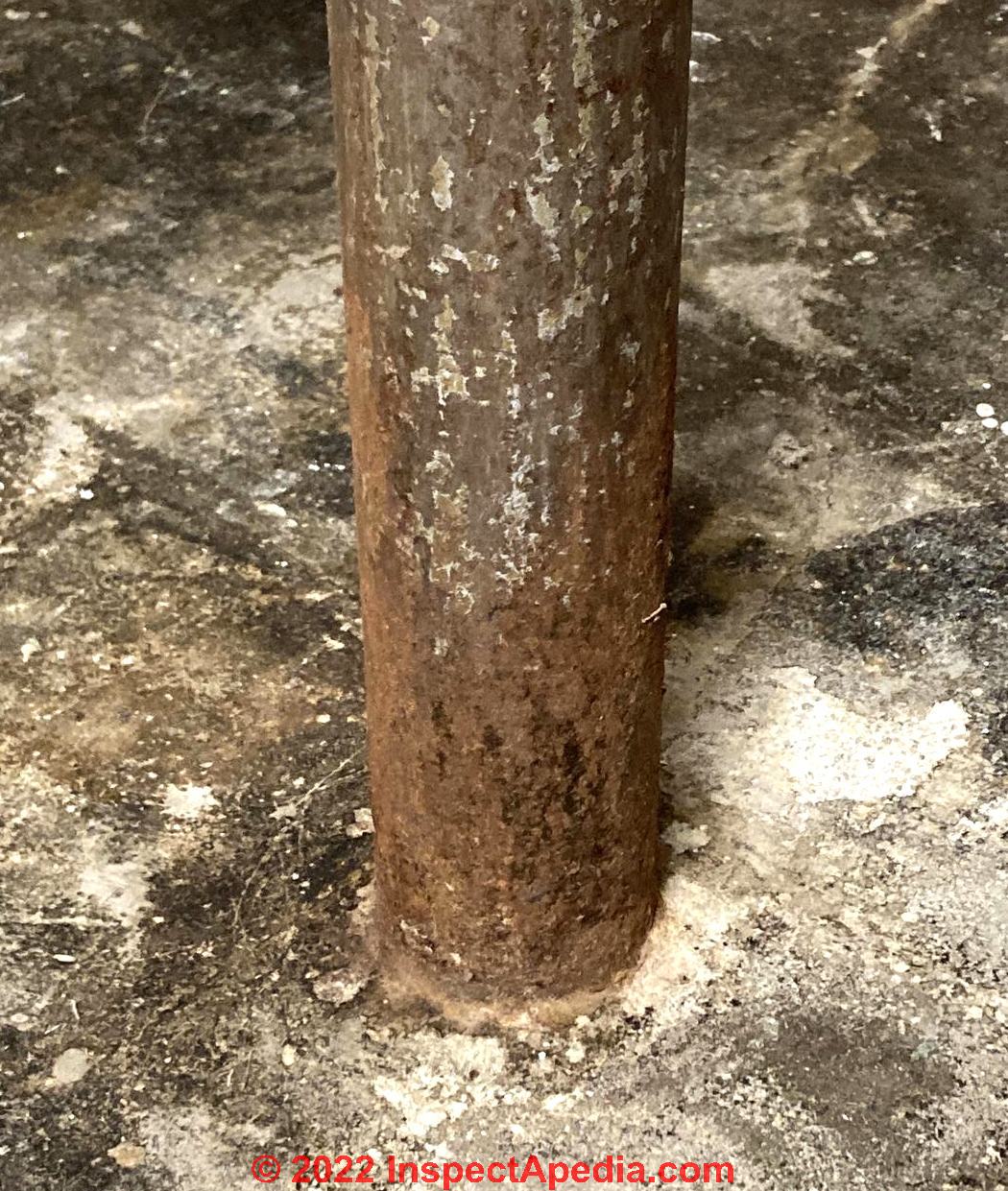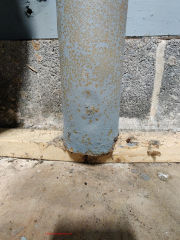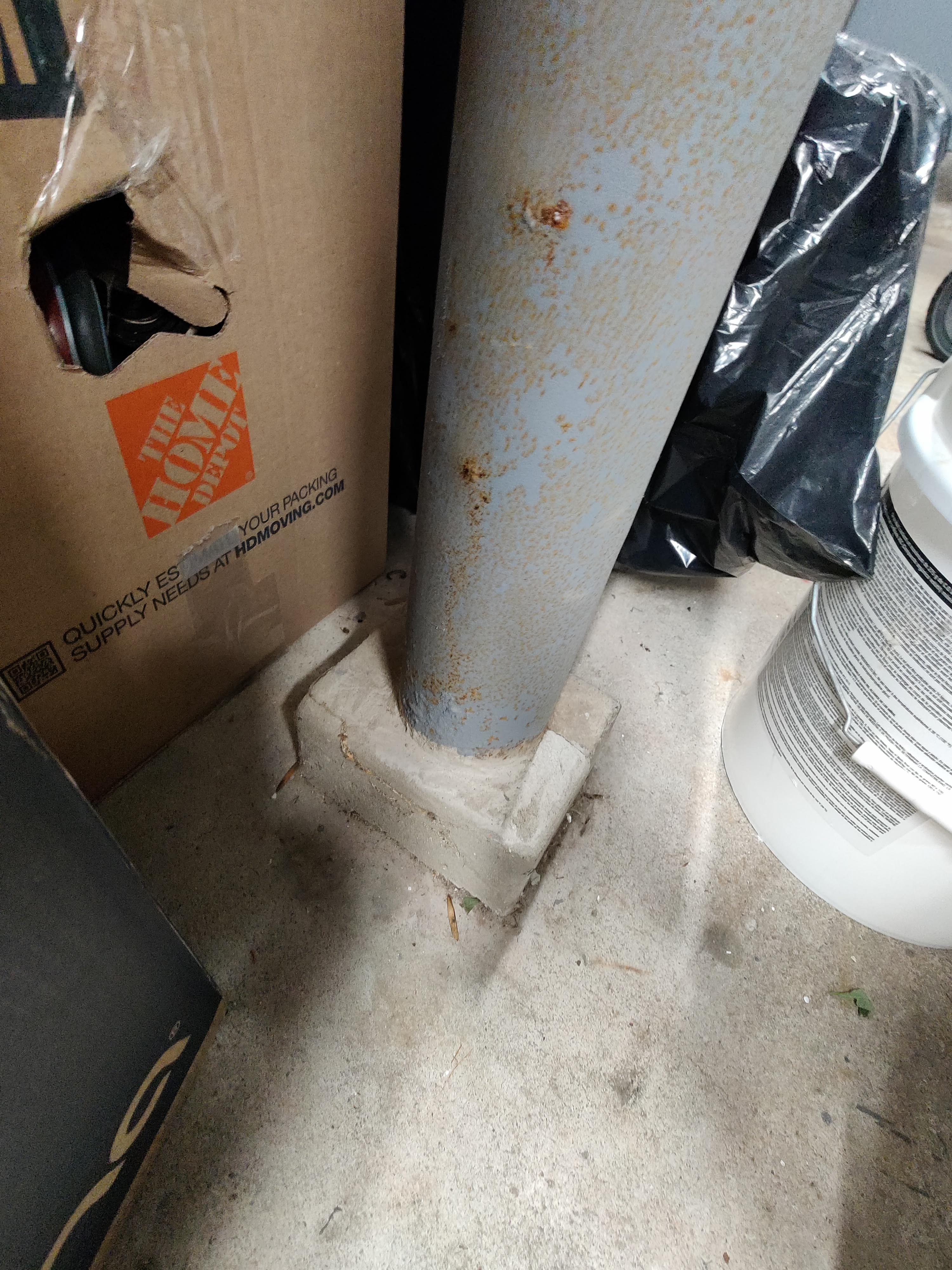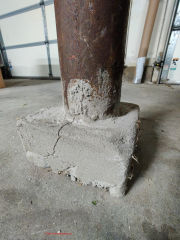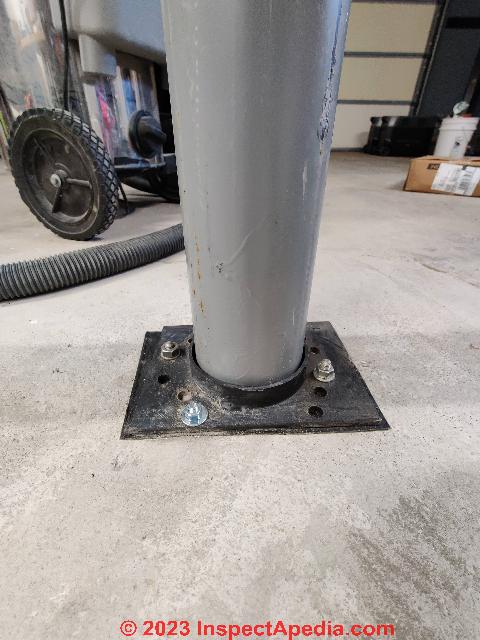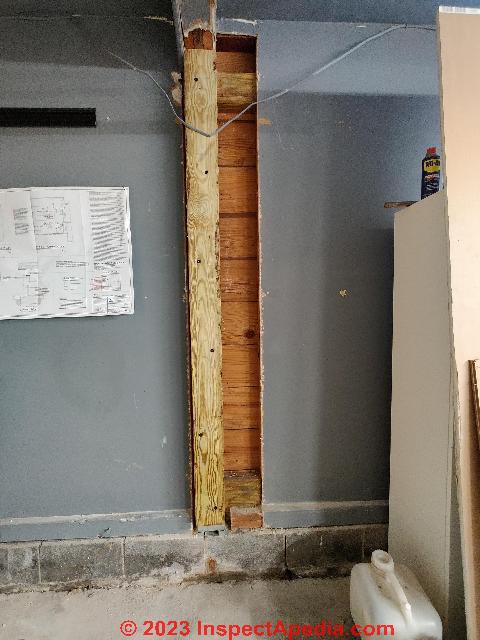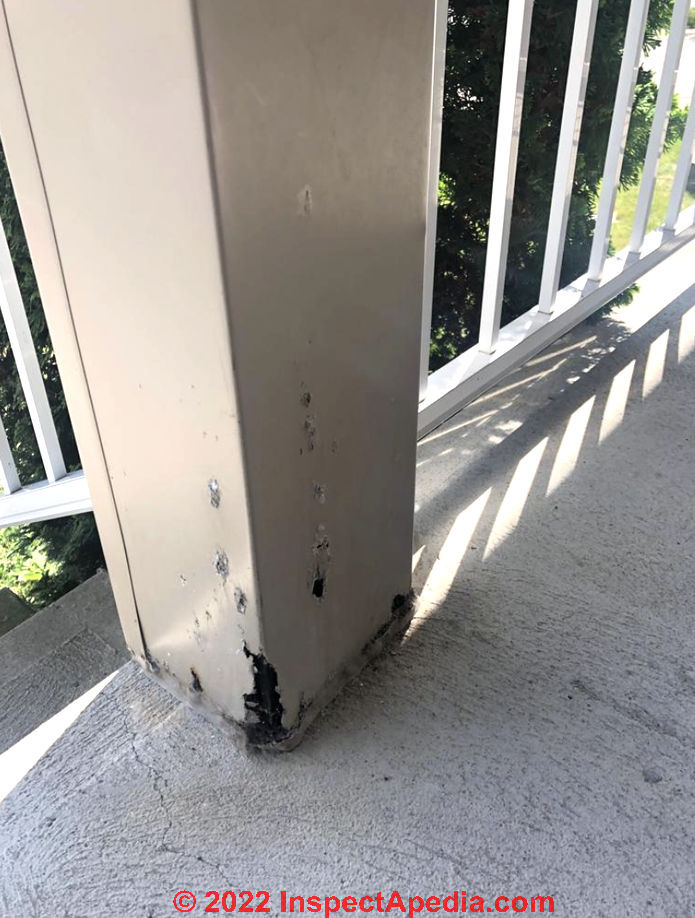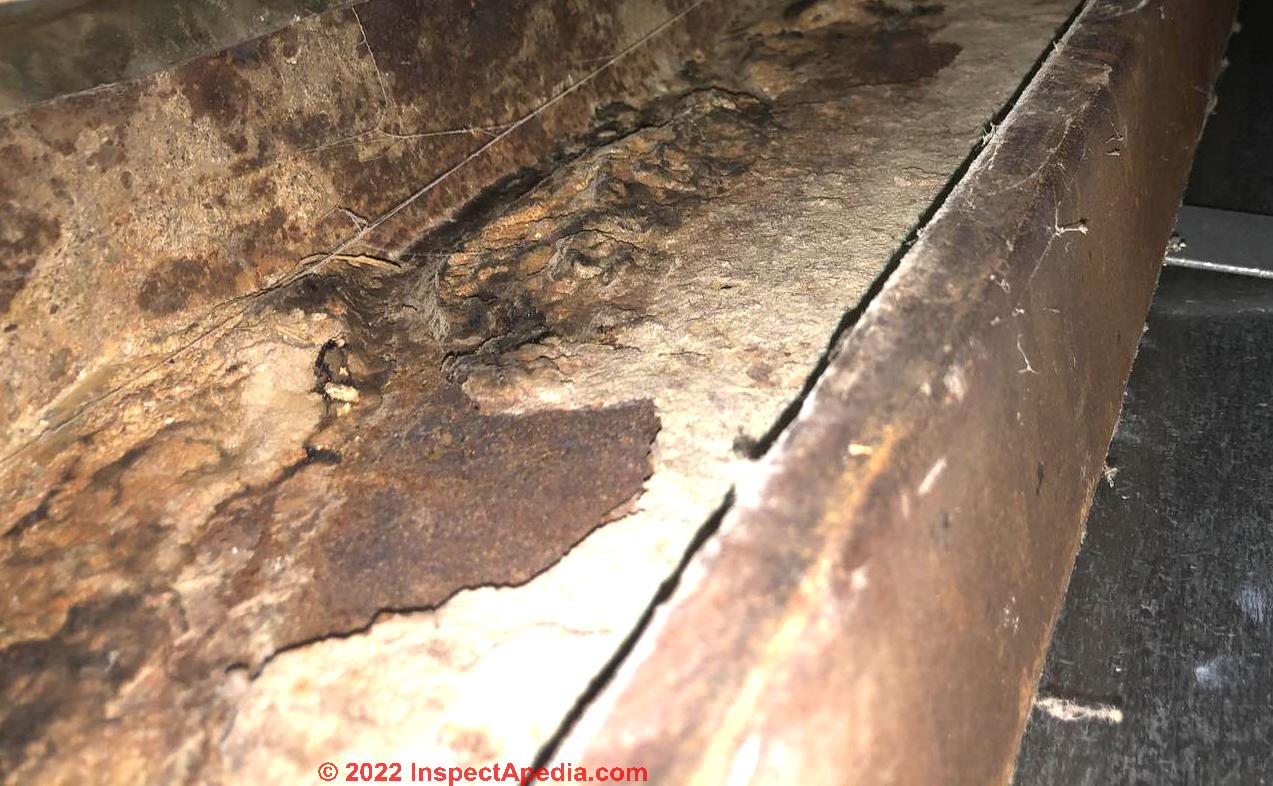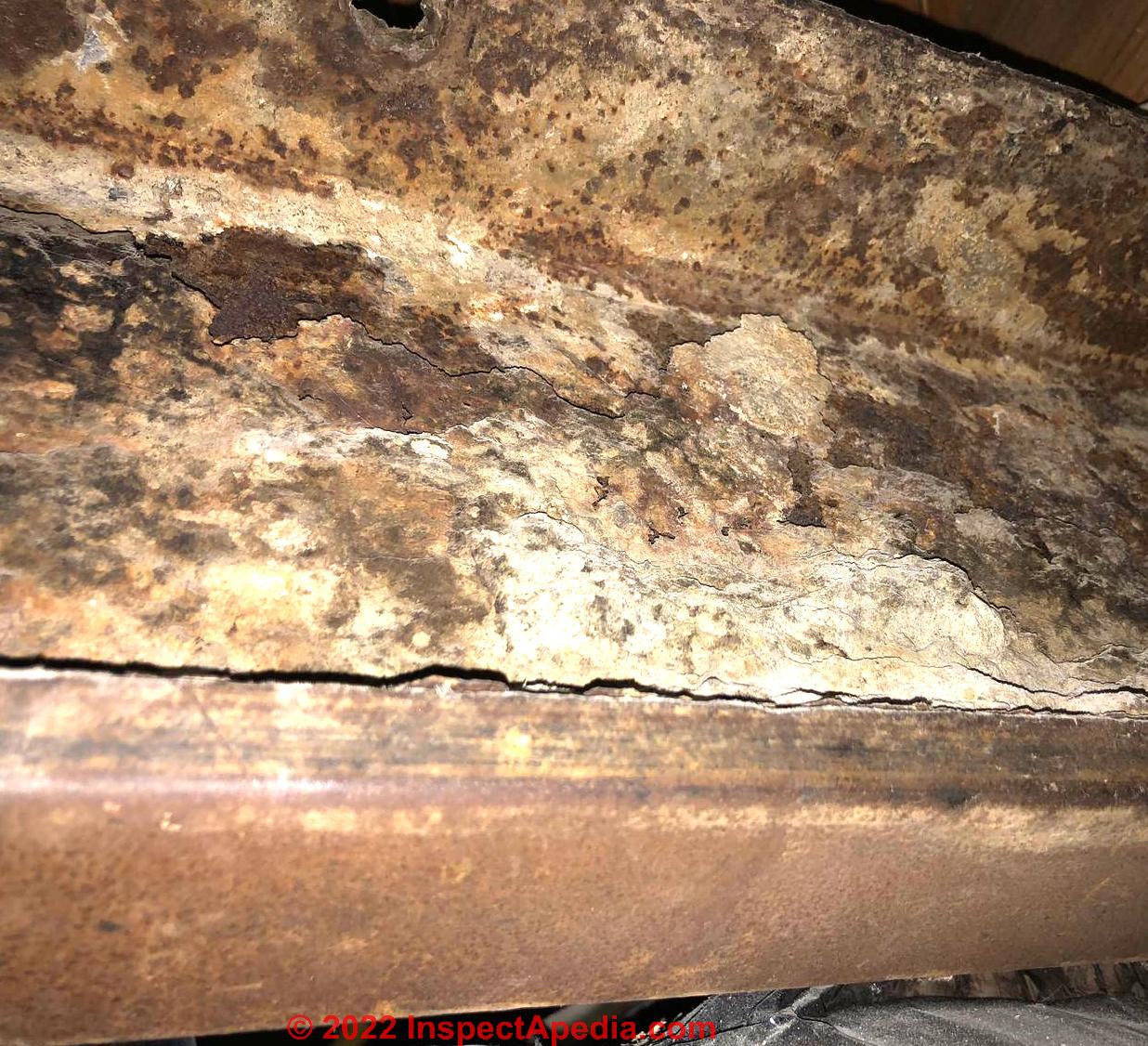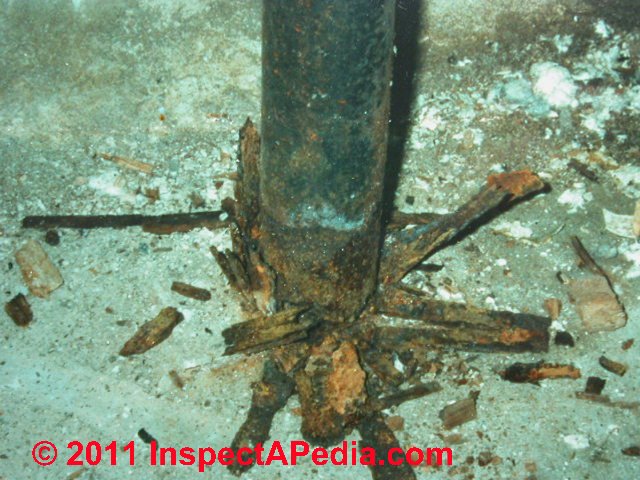 Steel Lally Column Rust Damage
Steel Lally Column Rust Damage
Rust on steel posts ranges from cosmetic to very dangerous
- POST a QUESTION or COMMENT about the types of structural column failure in residential & light commercial buildings: inspection, diagnosis, & repair
Rust damage to steel posts or columns:
We explain how to evaluate rust damage to steel columns, posts, adjustable columns in homes, and we illustrate the difference between harmless cosmetic or surface rust and serious exfoliating rust, splitting columns and risk of building or floor collapse.
This article series explains how to notice defective, damaged, improperly supported, or missing structural columns, and other structural column & pier mistakes.
Our page top photo shows a split, crushed steel column that resulted in the partial collapse of the floor above during an inspection by the author.
InspectAPedia tolerates no conflicts of interest. We have no relationship with advertisers, products, or services discussed at this website.
- Daniel Friedman, Publisher/Editor/Author - See WHO ARE WE?
How to Evaluate Rusting Steel Structural Columns & Posts That Can Risk Building Collapse
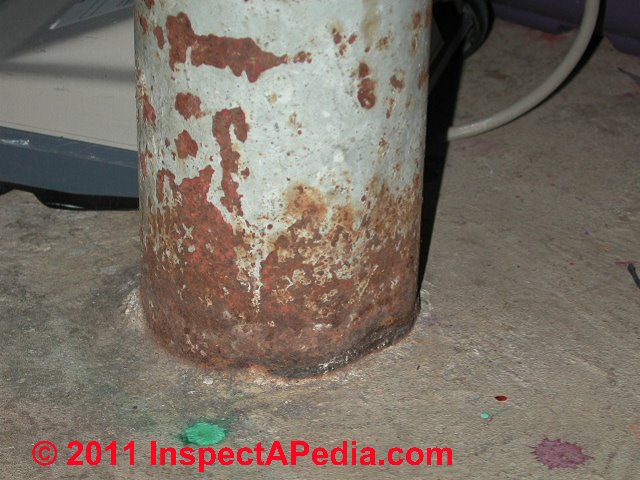
How to spot defective structural columns & piers in residential buildings. Examples of proper and improper use of teleposts, jackposts, and Red-I-Posts: adjustable or screw-jack columns.
Watch out: Some of these residential column or post defects are dangerous and risk collapse.
This article describes a structural column defects in residential buildings. Larger structures using supporting columns and piers certainly require additional professional design from a civil or structural engineer or similar design professional.
As we also discussed at BASEMENT LEAKS, INSPECT FOR, even a concrete filled steel Lally column can deteriorate enough to lead to building movement or instability. But hollow steel columns such as teleposts and even steel pipes people sometimes think will support a building, heavy exfoliating rust on the columns can lead to crushing or splitting and a structural collapse.
When evaluating the history of water entry in a building we like to look at structural components that have been in place since the building was completed - those are parts that will have been exposed to flooding or recurrent wet floors if water entry has been a problem.
Light superficial rust on a Lally column base is not structurally significant, though it might indicate a history of wet floors in the area.
The rust shown at the Lally column base at below left is just a chip, it is insignificant, and we concluded that there was no evidence of a history of wet floors in this basement area.
The steel column at below right penetrates the floor slab - we think it may sit on a hidden pier (there was no sign of settling).
But the column surface rust at below right suggests the floor has been wet in this area.
We did not think this column had suffered damage that risks it's structural integrity.
Click THIS PHOTO LINK [photo] to see another photo of rust on the base of a steel column in a basement that we verified over a 12 year life had been subjected to recurrent wet floors but never flooding.
More photos of superficial rust damage to a hollow residential structural steel post are
Comparing Surface Rust to Significant Exfoliating Rust on a Structural Column
But when we see exfoliating rust, some careful poking around to see just how much damage has occurred can help us decide the urgency of replacing the column - and of course fixing the water entry problem .
WATER ENTRY in BUILDINGS will help with the latter.
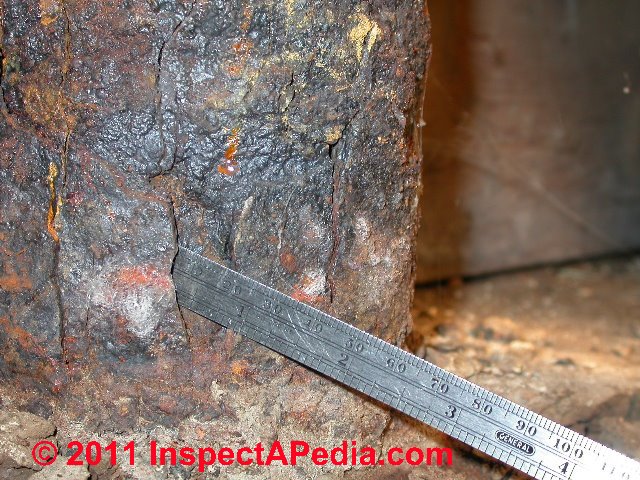
Example of Structural Steel Column Collapse & Floor Collapse Due to Rust
In our steel post rusty-base photo above we show serious exfoliating rust at the base of a steel column. It's reasonable to infer that this home has been subject to recurrent flooding to a depth of several inches.
If the post above is a traditional concrete-filled steel Lally column, even with rust damage it's resistant to sudden catastrophic collapse.
Watch out: however if the steel post is a hollow unit, severe rust can lead to either gradual or even sudden crushing of the bottom of the post - an event that can cause a building catastrophe.
Our inspection of a second rust-damaged structural steel post (photo below) was very exciting.
We were inspecting a house on Long Island when the owner mentioned that she had pumps running 24/7 in the basement to keep Long Island Sound at bay.
Some Long Island New York homes located close to the water were constructed with a basement floor that was close to or sometimes even lower than water levels in the nearby Long Island Sound or its waterways, creeks, canals. Those buildings invite constant water-entry problems and related water damage.
In this Long Island home there was a forest of steel supporting columns (some were just hollow pipes not real Lallys) in the basement - all of these steel posts were badly rusted.
As the owner, who was a big person, walked across the floor, the kitchen floor suddenly collapsed and fell down about a foot. We wondered if an earthquake had suddenly struck Long Island.
Trembling we both took another look in the basement. The Lally column shown above and supporting part of the kitchen floor had picked that moment to crush. It was rusted through from repeated flooding.
Also see FLOOD DAMAGE TO FOUNDATIONS.
How to Evaluate Dented, Lightly-Rusted Steel Posts or Columns
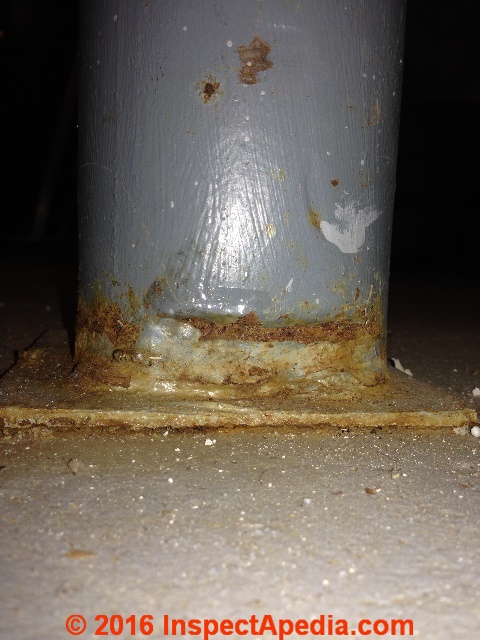 Question: Is this dented steel column a problem that needs to be addressed?
Question: Is this dented steel column a problem that needs to be addressed?
2016/11/25 [Anonymous by private email to the editor]
Today, as we were cleaning out our garage, we noticed that one of the support columns for our 1965 split level home has a large rusty dent (about an inch tall) at the bottom.
This support column, which we believe is original to the house, is holding up the second story bedrooms which extend over the garage.
We purchased the house about a year ago and do not know how long the dent has been present or what caused it. We have attached pictures taken from several angles.
Would you say this rusty, dented area is a problem that needs to be addressed or acceptable?
[Click to enlarge any image] Photo: a close-up of the bottom of the steel column described by the reader's question.
Reply: Tips for homeowner evaluation of the condition of a steel support column
Thank you for the interesting support-post question. A competent onsite inspection by an expert usually finds additional clues that would permit a more accurate, complete, and authoritative answer than we can give by email alone. With that arm-waving done, I comment further:
From just your photos I infer that there has probably been a history of wet basement floor in at least the area of the post. Given that the home is 50+ years old, the total amount of rust on original post is not terrifying. I can't tell if what you're seeing includes evidence of any actual crushing of the post bottom.
If the post is crushing then it's an older type, no longer permitted, that is hollow. A modern Lally column used in this location would be filled with concrete - a detail that resists both bending and crushing.
But many older homes used steel columns that were hollow. Just how much of a risk of structural damage hollow steel columns might suffer from rust depends on:
- The thickness and quality of the original steel and thus its ability to resist rust damage
- The amount of rust damage that has occurred.
While I'm not a structural nor civil engineer, I expect that those professionals would all agree that light, superficial rust on a steel column is only cosmetic in effect, though it might warn that steps should be taken (get rid of water, paint the steel) in a residential structure like yours to protect the column from further rust. Thick flaking exfoliating rust on the other hand, seriously compromises structural steel.
At COLUMN / POST RUST DAMAGE we show serious rust damage to a hollow steel column that crushed, resulting in the sudden collapse of a kitchen floor of a Long Island New York Home in an event that scared the hell out of the author.
I would pick up a hammer and first give rap or two on the post side at mid span. If it rings or sounds hollow, it may in fact be hollow, in which case IF there is crushing or bad rust you'll want to replace it. If the noise is more of a "thunk" the post is probably concrete-filled and crushing/bending of any significant amount is unlikely.
Below your photo shows this hollow steel column indoors in a finished garage.
Next, with a screwdriver, poke into the base of the post a bit. If you find it's soft rust and your screwdriver goes in to concrete, there's no urgent repair. If you find that the screwdriver pokes through rust into a hollow space up above the floor level then the column is hollow.
Finally: look for other signs of the extent of water entry and any related problems (moldy insulation, drywall, or rot or insect damage), and if needed, take steps to dry out the basement. A sickening amount of such guidance is at InspectApedia.com.
A good place to start is at WET BASEMENT PREVENTION or you can see this
extensive ARTICLE INDEX to BUILDING LEAKS & WATER ENTRY
Reader follow-up: so should we hire a structural engineer to look at this post?
Thank you so much for your helpful response. We tapped on the post with a hammer today and it seems to be hollow (As are the other three posts located in our house. If in good shape, are these other hollow ones considered to be ok?).
The metal of the dent was still intact, so we were unable to verify using the screwdriver approach.
The post is located in our garage and we believe the dent/crush area may be due to a horizontal impact of some kind.
The rest of the post seems to be in decent shape with the exception of this roughly 1 inch tall by three inch wide dented area. Should our next step be to hire a structural engineer?
Also, please feel free to share the photos
Moderator reply: no
With the caveat that nobody can afford enough insurance to promise a stranger that their house - completely unknown and un-seen except for a few photos sent by the correspondent - is "safe" or "structurally sound", still, looking at just your photos I can see no reason whatsoever to hire an expert for structural assessment.
If you saw signs of building movement, settlement, cracking, leaning, bending, bowing, heaving, then that would be a cause for further concern.
A dent in the bottom of one hollow steel column with light, non-exfoliating rust on the column base, is not justification for requiring a structural engineering analysis of the building.
Take a look around your home for signs of movement or for superficial, recent cosmetic repairs that might cover such movement, or for floors, walls, ceilings that if not cracked or bent, bulging, leaning bowing, are nevertheless visibly out of plumb, square or level.
I do not mean to sound glib, but in sum, there's not much justification for worry for just this one column if there is no settlement and no significant damage. Superficial or surface rust is not likely to itself represent damage to the structure.
The risk to you of being hurt falling down the stairs when going to the basement to look at this column is greater than the risk of the dented lightly-rusted column by itself.
I mean, watch out for a "capture error" in which something you see so captures your attention that you fail to attend other higher-risk situations.
Make sure your home has working smoke detectors/alarms, sound steps and railings, and that there are no obvious hazards in the electrical or heating systems.
If you had a home inspection prior to purchase of the home, you might ask the inspector if she/he saw signs of concern for damage to the structure as well as asking what repairs are needed to address Dan's 3 "D"s:
See FEAR-O-METER: Dan's 3 D's SET REPAIR PRIORITIES for an explanation of the importance of focusing your energy on things that are Dangerous, Don't work, or that are causing rapid, expensive Damage to the home.
and
see OTHER PEOPLE's MONEY for an explanation of why some consultants give you advice that is expensive for you, free for them, and that mostly is focused on reducing risk for the consultant rather than for you.
Reader follow-up: steps to protect the column from more damage
We appreciate your reassuring email and are certainly happier to think this is not a major problem.
In your previous email, does the word "crushing" refer to a vertical crush, like from a downward force? We had thought it included the horizontal impact (crush?) that may have caused the rusty notch at the bottom of our post. For the most part, our house seems as straight as an arrow.
We don't see any evidence of other settlement beyond a very slight dip in the threshold of the master bedroom and some uneven wall tile in the bathroom (we think it's just really old, poor tile). Everything else seems very strong and straight. The inspector did not have any structural concerns.
He did not see this area of the post in question due to lots of clutter, but from what he could see of the house, he raised no structural concerns.
One more question, if that's ok - in order to protect the column from further rust damage around the base, should we pick off the rust flakes and then paint over it? - 2016/11/28
Moderator reply:
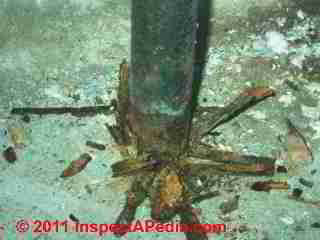 Thanks for the follow-up questions.
Thanks for the follow-up questions.
Horizontal "crushing" of a steel post or column: good point. I agree that a post or column might be damaged by horizontal impact, and I add that a dent might be caused by both impact (even a hammer) OR in a case of heavy loading or overloading of a too-thin, under-sized column denting could be an early stage in "crushing".
But those manifestations of column overloading in a residential property would be very very rare.
More likely somebody smashed a column near its top or base as a heavy-handed step in aligning the column to a plumb position.
If the column is hollow (a telepost, adjustable column, pipe, etc) denting is far more likely than if the column is filled with concrete (a Lally column).
When I refer to "crushing" I mean that a badly-rusted steel column actually crushed downwards from weight from above - shown in my photo just above, and discussed in more detail
starting
To protect the steel column in your home from further damage:
- Wire-brush the rusted areas of the column
- Probe the rusted areas to confirm that the rust is just superficial. If your screwdriver can, by hand, poke a hole in the column then it probably should be replaced.
- Paint the cleaned column with a rust-inhibitor paint and then if you like, a finish coat of your choice
- Find and fix sources of basement water entry
Splits in Steel Lally Columns
Question: Does this damaged lally column need to be replaced since it's filled with concrete?
We have concrete filled columns in the basement and garage that are rusting/cracking. If concrete filled, is it an issue?
We have concrete filled Support columns with rust issues. If concrete filled, is it an issue?
[Click to enlarge any image]
Moderator reply:
If what appears to be the case in your photo is correct, the steel Lally column is not just peeling and rusty, it has actually split.
A steel column like yours can split due to the pressures from exfoliating rust if the column is in water or if water has leaked into the column interior.
If that is the case then that column has failed and should be replaced.
The concrete and steel rely on one another. Neither, alone, is reliable as a structural building support.
The column could fail even in compression from the loads above, but worse, it has lost its resistance to bending and breaking.
Particularly for buildings located in an area where there could be strong destructive forces such as hurricanes, floods, winds, or earthquakes, a column that is damages like yours is almost certainly going to bend or break.
Take a look at what happened to some of the Lally columns at the Northridge earthquake (below) contributing to the collapse of Northridge Meadows and, sadly, fatalities.
The photo above is discussed at EARTHQUAKE DAMAGE PHOTOS CA 1994
...
Reader Comments, Questions & Answers About The Article Above
Below you will find questions and answers previously posted on this page at its page bottom reader comment box.
Reader Q&A - also see RECOMMENDED ARTICLES & FAQs
On 2022-10-29 by S.G. - iNACHI inspector says homeowner's "Stuff" blocked views of all six Lally columns that had severely rust-damaged bases - where did I go wrong?
The following discussion with an InspectApedia reader details extensive Lallhy column rust damage not reported at a home inspection (blocked access?) and then repaired by replacing the columns
Firstly thank you for this oasis of home inspection information. As a first time home owner this site has become my go to resource for any questions on the various systems that make up a home.
If you would be so kind, here is my current situation.
We closed on our single family home on 9/09/2022 and discovered two main things that look to have been missed by the home inspector a friend referred us to and we went with. Also note the inspector is credentialed with the InterNACHI organization.
1. There are signs of carpenter ants in the basement which were pointed out to us when we asked for a pest control person to come by for another issue with small animal sounds in our walls.
2. There was an expansion over the garage for the master bedroom which is supported by 6 lally columns. It turns out one of the footing has rusted off with the cement core exposed.
Another has two 2x4 wood blocks as a makeshift footer and interestingly enough a few of the other columns had cement wrapped around the footing of the columns which I'm not sure does anything other than hide the condition of the footers. Here attached pictures of all 6 lally column footers.
I have reached out to the inspector and he said that his inspection report comments specifically state that the sellers were on premises and their stuff was obstructing the view to these columns so he has no responsibility to bear. He said at most he can refund the cost of the inspection sans the cost of the radon test.
With hindsight being 20/20 I am curious where I went wrong with selecting a reputable inspector and I am resigned to eat the costs of these repairs but was curious what your take would be in my situation.
I will try to salvage something with the sellers if possible as we hit it off and are on friendly terms about these discoveries but will not be holding my breath there.
The house was built in 1960, so 62 years ago. As we were removing carpeting from a structural pipe, we noticed several inches of rust at the bottom of it.
We were actually surprised by this, because there seemed to be little to no settling in the house when we had our inspection.
We haven't followed your steps yet to determine if it's hollow or solid Lally columns, and haven't yet tried gently poking at it with a screwdriver to see if the rust is soft. We can try those steps, but wanted to see what you thought of it from this picture. Thanks!
Reply by InspectApedia-911 (mod) - 1960 Boston home with very rusty structural Lally columns in a home's basement?
@SG,
That's fairly thick crumbly rust or at least that's what it looks like to me. One would think that this basement has been repeatedly wet.I can't of course say anything about the extent to which your inspector's access to the basement and his ability to inspect it were blocked by stuff stored there by the seller, so I can't tell you what he should have seen or said about those very rusty Lally columns.
It's my OPINION that an experienced inspector, if he's allowed into the home at all, particularly into its basement or crawl space areas, has a good chance of picking up clues of prior building flooding or of recurrent basement water entry.
Sometimes the inspector might also report, if it's visually evident, signs even from outdoors that warn that a building is at risk of water entry and may have had such a history, with risk of related damage.
Just how much the inspector says about such risks depends on what he can see.
It's also the case in at least some home inspector association's Standards of Practice that when an inspector's access to specific building areas or systems is limited or prevented, he should tell you not only that he could inspect those things, but what sorts of risks you face and what you should do about them.
Some useful articles that I hope you'll read include the one above on this page and also
FLOOD DAMAGE ASSESSMENT, SAFETY & CLEANUP
HOME INSPECTION STANDARDS & ETHICAL CODES
WATER ENTRY in BUILDINGS - home
On 2022-10-29 by S.G.
@InspectApedia-911, agreed on the wetness. What do you think about the structural integrity of the post, given what you're seeing? Thanks!
On 2022-10-29 by InspectApedia-911 (mod)
@S.G.,
Having stated that it looks like thick crumbling rust and having no additional information about your home or probable water entry and damage, I wouldn't make a claim as to its stability or not.
A short message with a couple photos is not sufficient to diagnose a potential issue that could affect the structural integrity of your home.
Please understand that we don't want to bet your safety or money on scanty information and what would be too much speculation by anyone presented with a brief text and a single photo.
As you mentioned, you have not yet tried the steps we've outlined and recommend starting there.
Please take a look, follow those investigatory steps, and let us know both what you find and also whether any of that information is unclear or leaves you with questions.On 2022-10-30 by S.G. - steel column appears to be solid - filled with concrete
@InspectApedia-911, good news. We gave it a rap with a mallet, and the spouse is even more convinced than I am that it's solid. More importantly, the screwdriver didn't go into the Lally /at all/ when we poked at the rust all over.
(They reminded me that the pipe was covered with carpet . . . and we wouldn't be surprised if the pipe burst they had a year or two ago was pulled up into the carpet and caused the surface to rust.)
We looked at the other Lally - it had clearly been painted with antirust the first time around - and it had substantially less rust.
After a several turns alternating with some vinegar and a carbon steel wire brush (since I think Lally columns are also low-carbon steel?), it's looking a good bit better. We also gave the way less rusted other Lally the same treatment. I don't know if we have it in us to get them all the way down to bare metal, though.
We did our best to wipe it down with a damp cloth and then dry it with multiple paper towels, but I can't be 100% sure there aren't traces of vinegar still.
Now that we know this, a few more questions:Thanks again for all this; Inspectapedia is phenomenal.
- Is this surface enough that we could fairly safely paint it with antirust paint and call it a day?
- If so, any tips on that? (Or is there a page I should look at on here?)
- Anything else we should know? Do we have a 'ticking clock' to paint it now that we've removed most of the rust?
On 2022-11-01 by InspectApedia-911 (mod) - signs of recurrent water entry: look for the history and causes of water entry & fix any that remain, clean and paint rusty columns, double check for more-serious damage
@S.G.,
Yes I'd clean and paint the surface of the Lally and call it a day -
except to add a thorough look for the history and causes of water entry - that rusting in your photos is from more than a single event.
Was there a tile floor that was removed?On 2022-11-04 by S.G. - re: "add a thorough look for the history and causes of water entry - that rusting [in your photos] is from more than a single event."
Replying to the thread...
"except to add a thorough look for the history and causes of water entry - that rusting is from more than a single event."
Yeah, we agree. We'll be on the lookout for water infiltration, and will be running a dehumidifier for lighter moisture in the near future. (We have DampRid there now; we just need to buy the dehumidifier we plan to use.)
"Was there a tile floor that was removed?"
If so, it was a while ago. This was one of those unfortunate 'we used carpet in the "finished" part of the basement' situations, so the only thing we removed was carpet. But it's possible the owners before the last ones had tile at some point. What's that tell us, since you thought of it?On 2022-11-04 by InspectApedia (Editor)
@S.G.,
IF raw concrete was visible at the bottom of some of your Lally columns with all of the surrounding steel lost
THEN
That sort of rusting isn't from general dampness that would be cured by a dehumidifier (though using one is fine). There was water on the floor - either repeatedly or unattended for a very long time. It takes many months (or longer) for water to rust so entirely through a steel Lally column enough to expose the concrete filler of the column core.
Also in my opinion, if you've got several inches of nothing but concrete at the base of a Lally column - with all the steel gone, then that Lally must be replaced.
Lally columns as structural supports, require both the surrounding steel AND the concrete filler. Either, by itself, isn't sufficient.
IF exploration of a rusted Lally column finds just SURFACE RUST and not exfoliating crumbling splitting rust nor exposed concrete, THEN simply cleaning and painting the Lally columns should be sufficient repair, combined with an investigation into the history of building water entry and wet floors.
If there are regular square marks over much of the concrete floor in your basement that tells us that there was a tile floor and quite possibly it came loose, and was removed - as would happen if the floor were flooded or remained wet for a considerable time.
In a building with those signs, one would, at the very least, explore by a few test cuts, the condition of any finished basement walls - close to floor level - to check for rot and mold.On 2022-11-04 by InspectApedia (Editor) - Enough water entry to completely rust off the steel bottom of a Lally column -
@SG:
Enough water entry to completely rust off the steel bottom of a Lally column - as in your first photo - would surely have caused other signs of water entry in the building -
In my OPINION, IF there was evidence of a costly or dangerous problem at a building such that all the inspector had to do to see it was to direct his/her eyes in that direction, it ought to have been reported.
From just your note I don't know what other evidence was there for the "seeing".
When an area is not accessible for any reason in my OPINION the inspector ought to do more than tell you "we didn't inspect X" - he ought to give some help with warnings: how severe is the limitation? Might there be concerns meriting further inspection or investigation?
Did the piled up materials really prevent ANY inspection?
Did the piled up materials themselves suggest a cover-up?On 2022-11-04 by SG
@InspectApedia (Editor),
Thank you for that perspective, it seems in line with my understanding of a good faith effort to inspect the home regardless of seller occupancy. I appreciate your time and your website.On 2022-11-04 by InspectApedia (Editor)
@SG:
At Inspectapedia.com you'll find, if needed, articles describing Home Inspection standards and ethics as well as details of the evidence of building water entry and damage.
HOME INSPECTION STANDARDS & ETHICAL CODES
see also
INACCESSIBLE / SHUT_DOWN AREAS / EQUIPMENTOn 2022-11-04 by SG
@InspectApedia (Editor),
One last thing if would be so kind. I know that all home inspectors should protect themselves via two methods. 1. LLC or some legal structure 2. insurance for errors/omissions.
If I were to make a claim for the latter what is that process look like? To my laymen's eyes I would imagine it something akin to a car accident where you exchange insurance information and then submit a claim to the insurance company. Is that a naive take on how to file a claim for home inspector errors?
The inspector that worked on my home stated that the claim is more inline with suing the insurance company to pay for any errors/damages. I didn't realize that filing a claim for a poor home inspection was through a litigation method.On 2022-11-04 by SG - the Lally columns are in the garage not our basement
@InspectApedia (Editor),
Just wanted to add a correction as the Lally columns are in the garage not our basement but to your point on the fact that these columns/posts did not rust themselves so what the root cause will have to be investigated.
... home is located in central NJ in a Watchung.
I would estimate the age of the columns at around 25-30 years. I would defer attribution if that can in anyway connect me to someone else who can help my situation. I'll be glad to do it.
Recent news on the situation I will be getting an architect to take a look at the columns and he will check to see what kind of footing is required for the load that on the columns which supports a master bedroom expansion over the garage.On 2022-11-04 by InspectApedia Publisher - Rusty garage Lally columns: history of exposure to snow melt & salt? - Wow so many examples of history of water & rust at this home!
@SG,
In a garage it's possible that salt-embedded snow melting off of a car can cause more-rapid corrosion of steel lally column bases. But it's still a bit extreme and unusual to find all of the steel gone on at least one column - the corrosion had to be ongoing for some time.
If you don't have other architectural, design, or structural assessment questions, you might spend your money simply on replacing the Lallys and checking for water damage at the bottom of those garage walls.It sounds like you're on top of this problem. To keep me posted and if you find anything interesting send me a photo or two I may be able to offer a useful comment.
Frankly, with the apology that I'm always embarrassed to pretend to inspect a building by email, it's just boggles my mind that there could be so many points of evidence of a history of water, perhaps salt, and damage to those columns that an inspector could not have had anything to say about them. It almost looks as if he simply never went in the garage.
That's disappointing.On 2023-01-11 by SG - Repair of lally columns have been completed
I just wanted to reachout with an update on my situation with the lally columns. I've contracted with a local person and worked with an architect who found a better design that saved on some costs.
The quick summary is that we were able to remove two lally columns as they were adjacent to the outer wall of the garage and use simpson ties to use the underlying cinderblock foundation with lvl beams to substitute for support. Since they were so far away from were the cars would be parked shear strength was not needed there.
For the remaining four lally columns they were replaced with new columns as well as a rubber shim on a steel plate and fasted to newly poured concrete of 2'x2' square and 2' deep at 3200psi only the center columns had rebar underneath.
Here are a few photos of the result.
I am still in the process of trying to recoup something from the E&O insurance provider of my home inspector. I found it strange that a claim can only be made through the inspector themselves, it seems like a conflict of interest and probably explains why it has been so hard to reach my home inspector to speak more about this process.
I hope this helps your readers in some small way and that I pay forward a small contribution to your site that has helped me be a much more knowledgeable homeowner. - Anonymous 2023/01/04
I include other images of the structural repairs to columns using both steel Lallys and treated wood and glulam beam/posts.
On 2021-11-17 by Sona - How do I repair rust at the bottom of my porch column?
Column in the front of the house at base is rusted. How to repair this? Any suggestion/info are appreciated. Thanks posting the photo below
On 2021-11-18 by Inspectapedia Com Moderator - repair approach to a damaged column
@Sona,
I can't tell from your photo that that's a steel column. Are you sure it's not wood - and rot?
The repair approach to a damaged column is going to depend on
And repair ranges from cut off and add a base to a wood column to full column replacement.
- the column material
- its function or load
- its condition: extent of damage - and thus urgency
- the damage cause
An inspector might probe the post bottom to decide if what we see in your photo is superficial or something more serious.
If the probe, e.g. a simple screwdriver, doesn't penetrate more than an eight of an inch the damage looks superficial.
On 2021-06-06 by Carole A. Otto - is it a worry if a metal post in my garage is rusty?
I have a two-car attached garage with a finished room above in CT. There is one center metal post supporting it. No water ever gets into my garage except when my car has been rained on and it drips off the car and seems to pool around the post. I see rust and some peeling.
Should I be worried? if so who - what type of skilled person do I need to investigate and possibly replace?
On 2021-06-07 by mak.church (mod) - center support metal post in garage is rusting
@Carole A. Otto,
If you can post a photo here of the steel column, that would help us better answer your question and comment further. The above page illustrates superficial rust vs. serious rust-damaged structural columns.
Re: seriousness or urgency of issue: if the "column" is a proper one, it's 4" or larger in diameter and is filled with concrete - which helps prevent bending or sudden collapse. But if the "column" is basically a hollow steel pipe, the risk of a serious collapse when the column is badly rusted is much greater.
So again, reviewing the above information on this page will be helpful as well as sharing a photo.
On 2021-02-03 by Simon - large flakes of rust on both sides of my basement H-Beam
Hi, I recently discovered what appears to be large flakes of rust (or maybe old, lifting paint?) on both sides of the H Beam running across the basement of our 65 year old home. Is this typical or something I should be concerned?
I’m not sure what the “lumps” you can see are. It is in our furnace room around our duct work and looks like the previous owner recently painted the more accessible areas of the beam. Could moisture in the air cause this? Cant figure out how moisture would get at it otherwise.
On 2021-02-03 by danjoefriedman (mod) - rust-damaged H-beam
Thank you for the rust-damaged H-beam photo and question, Simon;
I can't se eenough to be confident that I understand what's going on here, but from just the limited view we have, this looks like a thin steel beam that was filled with concrete to obtain strength; the surface of the concrete may be spalling - a condition rising from a combination of moisture and poor original concrete mix.I also see what looks like a dead bird atop this beam.
Has this basement ever been flooded? Have you had the home inspected for other signs of flood damage?
Could that deposit atop the beam include mud?
FLOOD DAMAGE ASSESSMENT, SAFETY & CLEANUP may be of help in answering this question.
Watch out: if, however, further inspection shows that there is cracking or sagging in this beam or if you find that it has actually lost an entire surface of steel to expose concrete, I'd be concerned that the beam was no longer reliable and replacement or support may well be needed for safety.
On 2021-02-03 by Simon
@danjoefriedman,thanks for your reply. I can’t say for sure but I don’t think it’s concrete. The layer that comes off is quite thin for the most part and the beam underneath seems otherwise intact, albeit rusty. Will send a few additional photos to try and give a better view.
On 2021-02-03 by danjoefriedman (mod)
Simon
So is that white-gray material a coating? Perhaps remains of a fire-resistant coating?
If you don't see thick flaking cracking exfoliating rust (described in this article series) and the beam isn't sagging, you may be ok.
On 2019-10-22 by Mike - what does rust at the bottom of a steel column mean?
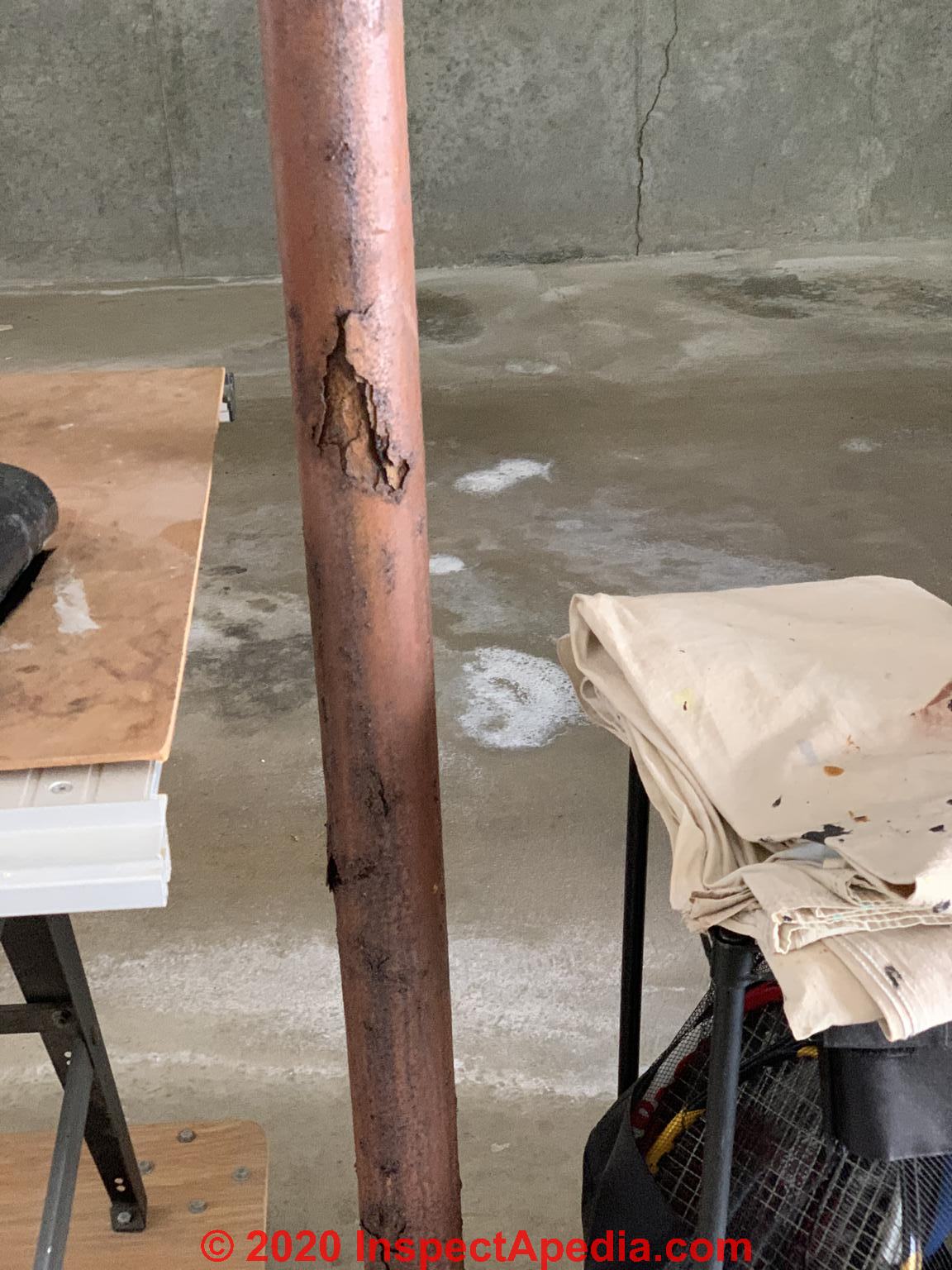 Hi, what does rust at the base of the steel column poles indicate?
Hi, what does rust at the base of the steel column poles indicate?
On 2020-06-02 - by (mod) - rust damaged jackpost or telepost - perforated, exfoliating crumbling rusty column = replace it.
From the scale of other objects in your photo, I think that looks like a telepost, not a real structural column (that would have been concrete-filled) - but I can't be sure from the photo.
The rust looks bad enough that the column should be replaced.If it's a telepost or "jackpost" it would be better to replace it with a true concrete-filled steel Lally column.
On 2020-06-02 by Anonymous
See the photo [above]
On 2019-10-22 - by (mod) -
Wet floors from leaks or water entry. Post a photo?
On 2019-01-02 by Rob - Choose steel post repair depending on extent of rust damage
Thanks for some great observations on previous posts - very informative.
I have what appears to be a hollow support column holding up the corner of the roof, and it is routinely exposed to water, as it is an outdoor structure (photos enclosed). Exfoliating rust has appeared 1-2" above paver grade, so I took out the pavers to find more rust below.
(This is a Florida installation about 5 miles from the ocean as the crow flies.)
Based on your other recommendations, a good course of action seems to be to scrape and wire-brush the flaking rust off first, then seal it with a rust inhibiting paint, and after drying, maybe build a 1"-thick concrete collar around it. It will ALWAYS be exposed to water based on its outdoor location.
What are your thoughts?
MAGE LOST by older version of Clark Van Oyen’s useful Comments code - now fixed. Please re-post the image if you can. Sorry. Mod.
On 2019-01-02 - by (mod) - hollow support column rust needs repair
Rob
I agree with your plan of action provided the rust damage has left most of the original steel.
If you can poke a screwdriver through the rusty post base then your options are
Temporarily support the roof, then
1. replace the entire post, installing a pier to get the steel above ground. This is the best and most-durable repair. The new pier, when cast, will include an appropriate connector bolt or bracket to secure the post bottom.
2. similar to option 1, but just cut off the bottom of the post at a height that will let you connect it to a new pier poured in place up to the post bottom and above ground.
3. cut off and have a welder weld-on a new post base - how old is this post and how old is the home? Maybe this is not worth the trouble, and maybe it'd cost as much (to get a welder on site) as just replacing the whole post
4. if the rust hole you made with our screwdriver is limited in size you could do what my dad called a "jackleg" repair - i.e. creative and amateur but that might work: drill a hole about 24" above ground, big enough to pour cement mix into the hollow post, and fill it up, engaging in the fantasy that the concrete core will help prevent a calamitous collapse.
I've seen all four of these approaches - IMO #1 or #2 are the best options.
Question: Are these damaged car porch support posts repairable?
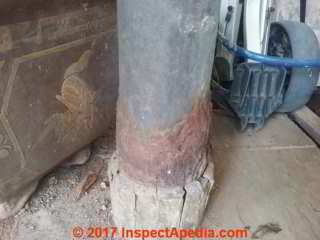 Our car porch was built 23 years ago and consists of a metallic frame supported by four hollow metal columns (each with a 4.2-inch diameter) and is covered with a ceramic-tiled roof, vide attached photos.
Our car porch was built 23 years ago and consists of a metallic frame supported by four hollow metal columns (each with a 4.2-inch diameter) and is covered with a ceramic-tiled roof, vide attached photos.
Lately we discovered to our horror that the 4 metal pillars are corroding with one covered with heavy thick rust flakes.
Before we engage a building engineer to have a look, there are several disturbing questions running through our minds at the moment such as:
1. Will any repair/s ensure that it will last at least another 10 years?
2. It cost us US$10000 to build it in 1994. Repairing it might cost at least half that sum and rebuilding another similar structure might cost at least thrice the original price.
3. In the interest of safety, would it be better to demolish it altogether. After all, we don't really need a roof over our car.
My wife and I would appreciate your expert advice and views on how we should proceed. - Anonymous by private email 2017/12/05
Reply: two repair approaches for damaged steel column repairs
You are right to be concerned about the columns in your photos, particularly because you report that they are hollow steel. A hollow steel column, if badly rusted, can crush at its rusty bottom, leading to a structural failure.
From your photo above it looks as if someone tried a previous repair by wrapping the column bottom in concrete.
The fact that that concrete wrap is splitting suggests that the column bottom is crushing and expanding.
I cannot of course fully understand the situation from just photos, but from what I can see I would think there is absolutely no need to demolish or abandon this car-porch (or carport) just to repair the columns.
When you replace the columns you might consider using concrete filled steel posts if they are available, or otherwise taking care to coat the post bottoms and to do what you can to protect them from corrosion.
There are two approaches that a contractor would take for replacing the columns in your car porch:
1. If the loss of space were no issue he might leave the existing columns in place, and would add new columns next-to the existing ones in a position that lets the top of the column be connected to the overhead beam.
2. if the loss of space by having double side-by-side columns is a problem or if that repair is just too ugly, the contractor would install temporary support columns a few feet away from the existing ones, to give working space.
Then he would remove and replace the existing columns one-by-one.Or your contractor may have a different idea - do tell me, and keep me informed about what you decide and how that work goes, as I may be able to suggest other questions in follow-up.
Photo: detail suggesting the points at which the top of these steel car porch columns were probably welded to the roof structure and where angled supports were included.
Reader follow-up: repair damaged hollow-steel columns by pumping on concrete
I've also consulted my two close friends who are engineers and they concurred with your advice that there is no necessity to demolish the structure.
They suggested I should get a good contractor who is familiar with such repairs to do the job.
I managed to get one who will start work tomorrow.
He recommended scraping off the rust from the bottom of each column and repaint the bases with antirust.
This will be followed by drilling a small hole to pump in a strong cement composite into column base and seal the holes before wrapping each column base with a strong cement footing.
Thank you to our readers for their generous comments
Thanks for this resource
Thank you for this oasis of home inspection information. As a first time home owner this site has become my go to resource for any questions on the various systems that make up a home. - On 2022-10-29 by S.G.
Thank you so much for this amazing resource for a new home owner like myself. I was searching for lally column rust issues and I've hit the motherlode. I'll be coming back here frequently to get my knowledge up to snuff. - On 2022-10-20 by Daniel
Thanks for some great observations on previous posts - very informative. - On 2019-01-02 by Rob
Reply by InspectApedia (Editor)
@Daniel and S.G. and our other readers:
Thank you for your generous comments. We've worked hard on this material for decades so we're very grateful when a reader finds it useful.
Your questions, criticism, or content suggestions are also very helpful and very welcome.
...
Continue reading at PIPES USED as POSTS? or select a topic from the closely-related articles below, or see the complete ARTICLE INDEX.
Or see COLUMN / POST RUST DAMAGE FAQs - questions and answers posted originally on this page
Or see these
Recommended Articles
- BASEMENT LEAKS, INSPECT FOR
- COLUMNS & POSTS, DEFECTS
- FLOOD DAMAGE TO FOUNDATIONS
- SETTLEMENT CRACKS in SLABS
Suggested citation for this web page
COLUMN / POST RUST DAMAGE at InspectApedia.com - online encyclopedia of building & environmental inspection, testing, diagnosis, repair, & problem prevention advice.
Or see this
INDEX to RELATED ARTICLES: ARTICLE INDEX to BUILDING STRUCTURES
Or use the SEARCH BOX found below to Ask a Question or Search InspectApedia
Ask a Question or Search InspectApedia
Try the search box just below, or if you prefer, post a question or comment in the Comments box below and we will respond promptly.
Search the InspectApedia website
Note: appearance of your Comment below may be delayed: if your comment contains an image, photograph, web link, or text that looks to the software as if it might be a web link, your posting will appear after it has been approved by a moderator. Apologies for the delay.
Only one image can be added per comment but you can post as many comments, and therefore images, as you like.
You will not receive a notification when a response to your question has been posted.
Please bookmark this page to make it easy for you to check back for our response.
IF above you see "Comment Form is loading comments..." then COMMENT BOX - countable.ca / bawkbox.com IS NOT WORKING.
In any case you are welcome to send an email directly to us at InspectApedia.com at editor@inspectApedia.com
We'll reply to you directly. Please help us help you by noting, in your email, the URL of the InspectApedia page where you wanted to comment.
Citations & References
In addition to any citations in the article above, a full list is available on request.
- Avongard FOUNDATION CRACK PROGRESS CHART [PDF] - structural crack monitoring
- BASEMENT MOISTURE CONTROL [PDF] U.S. Department of Energy
- Building Pathology, Deterioration, Diagnostics, and Intervention, Samuel Y. Harris, P.E., AIA, Esq., ISBN 0-471-33172-4, John Wiley & Sons, 2001 [General building science-DF] ISBN-10: 0471331724ISBN-13: 978-0471331728
- Building Pathology: Principles and Practice, David Watt, Wiley-Blackwell; 2 edition (March 7, 2008) ISBN-10: 1405161035 ISBN-13: 978-1405161039
- The Circular Staircase, Mary Roberts Rinehart
- Construction Drawings and Details, Rosemary Kilmer
- CRAWL SPACE MOISTURE CONTROL [PDF] U.S. Department of Energy
- Diagnosing & Repairing House Structure Problems, Edgar O. Seaquist, McGraw Hill, 1980 ISBN 0-07-056013-7 (obsolete, incomplete, missing most diagnosis steps, but very good reading; out of print but used copies are available at Amazon.com, and reprints are available from some inspection tool suppliers). Ed Seaquist was among the first speakers invited to a series of educational conferences organized by D Friedman for ASHI, the American Society of Home Inspectors, where the topic of inspecting the in-service condition of building structures was first addressed.
- Design of Wood Structures - ASD, Donald E. Breyer, Kenneth Fridley, Kelly Cobeen, David Pollock, McGraw Hill, 2003, ISBN-10: 0071379320, ISBN-13: 978-0071379328
This book is an update of a long-established text dating from at least 1988 (DJF); Quoting:
This book is gives a good grasp of seismic design for wood structures. Many of the examples especially near the end are good practice for the California PE Special Seismic Exam design questions. It gives a good grasp of how seismic forces move through a building and how to calculate those forces at various locations. THE CLASSIC TEXT ON WOOD DESIGN UPDATED TO INCLUDE THE LATEST CODES AND DATA. Reflects the most recent provisions of the 2003 International Building Code and 2001 National Design Specification for Wood Construction. Continuing the sterling standard set by earlier editions, this indispensable reference clearly explains the best wood design techniques for the safe handling of gravity and lateral loads. Carefully revised and updated to include the new 2003 International Building Code, ASCE 7-02 Minimum Design Loads for Buildings and Other Structures, the 2001 National Design Specification for Wood Construction, and the most recent Allowable Stress Design. - Building Failures, Diagnosis & Avoidance, 2d Ed., W.H. Ransom, E.& F. Spon, New York, 1987 ISBN 0-419-14270-3
- Domestic Building Surveys, Andrew R. Williams, Kindle book, Amazon.com
- Defects and Deterioration in Buildings: A Practical Guide to the Science and Technology of Material Failure, Barry Richardson, Spon Press; 2d Ed (2001), ISBN-10: 041925210X, ISBN-13: 978-0419252108.
- Guide to Domestic Building Surveys, Jack Bower, Butterworth Architecture, London, 1988, ISBN 0-408-50000 X
- "Avoiding Foundation Failures," Robert Marshall, Journal of Light Construction, July, 1996 (Highly recommend this article-DF)
- In addition to citations & references found in this article, see the research citations given at the end of the related articles found at our suggested
CONTINUE READING or RECOMMENDED ARTICLES.
- Carson, Dunlop & Associates Ltd., 120 Carlton Street Suite 407, Toronto ON M5A 4K2. Tel: (416) 964-9415 1-800-268-7070 Email: info@carsondunlop.com. Alan Carson is a past president of ASHI, the American Society of Home Inspectors.
Thanks to Alan Carson and Bob Dunlop, for permission for InspectAPedia to use text excerpts from The HOME REFERENCE BOOK - the Encyclopedia of Homes and to use illustrations from The ILLUSTRATED HOME .
Carson Dunlop Associates provides extensive home inspection education and report writing material. In gratitude we provide links to tsome Carson Dunlop Associates products and services.


